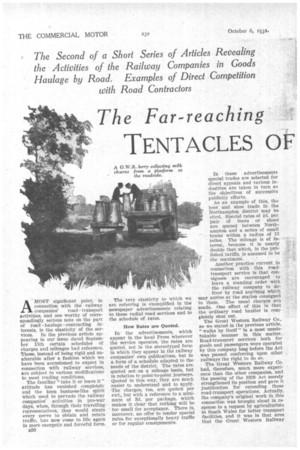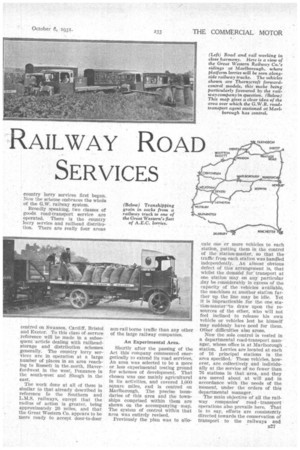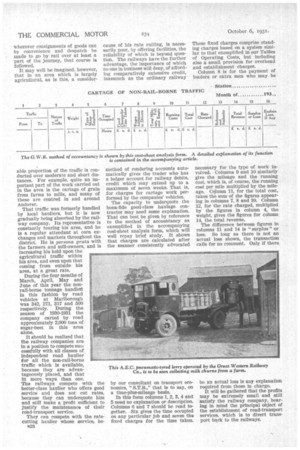The Far-reaching
Page 44

Page 45

Page 46

If you've noticed an error in this article please click here to report it so we can fix it.
TENTACLES OF RAILWAY ROAD SERVICES
The Second of a Short Series of Articles Revealing the Activities of the Railway Companies in Goods Haulage by Road. Examples of Direct Competition with Road Contractors
AMOST significant point, in connection with the railway
companies' road transport activities, and one worthy of correspondingly serious note on the part of road haulagecontracting interests, is the elasticity of the services. In the previous article appearing in our issue dated September 15th certain schedules of charges and mileages had reference. These, instead of being rigid and unalterable after a fashion which we have been accustomed to expect in connection with railway services, are subject to various modifications to meet trading conditions.
• The familiar "take it or leave it" attitude has vanished completely and the keen business-like spirit which used to pervade the railway companies' activities in pre-war days, when, through their travelling representatives, they would strain every nerve to obtain and retain traffic, has now come to life again in more energetic and forceful form.
528 The very elasticity to which we are referring is exemplified in the newspaper advertisements relating to these radial road services and to the schedule of rates.
How Rates are Quoted.
In the advertisements, which appear in the local Press wherever the service operates, the rates are quoted, not in the stereotyped form in which they appear in the railway companies' own publications, but in a form of a schedule adapted to the needs of the district. The rates are quoted not an a mileage basis, but in relation to point-to-point journeys. Quoted in this way, they are much easier to understand and to apply. The charges, too, are quoted per el,vt., but with a reference to a minimum of Rd. per package, which makes it clear that nothing will be too small for acceptance. There is, moreover, an offer to tender special rates for exceptionally heavy traffic or for regular consignments. In these advertisements special trades are selected for direct appeals and various industries are taken in turn as the objectives of successive publicity efforts.
As an example of this, the boot and shoe trade in the Northampton district may be cited. Special rates of id. per pair of boots or shoes are quoted between Northampton and a series of small towns within a radius of 15 miles. The mileage is of interest, because it is nearly double that which, in the published tariffs, is assumed to be the maximum.
Another practice current in connection with this roadtransport service is that consignees are encouraged . to leave a standing order with the railway company to deliver by road anything which may arrive at the station consigned to them. The usual charges an., made. One effect of this is -that the ordinary road haulier is completely shut out.
The Great Western Railway Co., as we stated in the previous article, "walks by itself" in a most unmistakable manner in this matter. Road-transport services both for goods and passengers were operated by this company long before the Act was passed conferring upon other railways the right to do so.
The Great Western Railway Co. had, therefore, much more experience than the other companies, and the passing of the 1928 Act merely strengthened its position and gave it justification for extending these road-transport operations. Actually, the company's original work in this connection was brought about in response to a request by agriculturists in South Wales for better transport facilities, and it was in that area that the Great Western Railway country lorry services first began. Now the scheme embraces the whole of the G.W. railway system.
Broadly speaking, two classes of goods road-transport service are operated. There is the country lorry service and railhead distribution. There are really four areas centred on Swansea, Cardiff, Bristol and Exeter. To this class of service reference will be made in a subsequent "article dealing with railheadstorage and distribution schemes generally. The country lorry services are in operation at a large number of places in an area reaching to Rossett in the-north, Haverfordwest in the west, Penzance in the south-west and Slough in the east.
The work done at all of them is similar to that already described in reference fo the Southern and L.M.S. railways, except that the radius of action• is greater, being approximately 20 miles, and that the Great Western Co. appears to be More ready to accept door-to-door non-rail borne traffic than any other of the large railway companies.
An Experimental Area.
Shortly after the passing of the Act this company commented energetically to extend its road services. An area was selected to be a more or less experimental testing ground for schemes of development. That chosen was one mainly agricultural in its activities, and covered 1,000 square miles, and is centred on Marlborough. The precise boundaries of this area and the townships comprised within them are shown on the accompanying map. The system of control within that area was entirely revised.
Previously the plan was to allo
(Left) Road and rail working in close harmony. Here is a view of the Great Western Railway Co.'s sidings at Marlborough, where platform lorries will be seen along. side railway trucks. The vehicles shown are Thorn ycroft forward. control models, this make being particularly favoured by the railway company in question. (Below) This ma P gives a clear idea of the area over which the G.W.R. road. transport agent stationed at Marl borough has control.
.cate one or more vehicles to each station, putting them in the control of the station-master, so that the traffic from each station was handled independently. An ' almost obvious defect of this arrangenient is, that whilst the demand for transport at one station may on any particular slay be considerably in excess of the capacity of the vehicles available, the machines at another station farther up the line may be idle. Yet it is impracticable for the one. station-master"to draw upon the resources of the other, who will not feel inclined to release his own vehicle or vehicles lest he himself may suddenly have need for them. Other difficulties also arose.
Now the sole control is vested in a departmental road-transport manager, whose office is at Marlborough station. Lorries are located at each of 16 principal stations in the area specified.. These vehicles, however, are collectively and individually at the service of no fewer than 76 stations in that area, and they are moved about at will and in accordance with the needs of the moment, under the orders of this departmental manager.
The main objective of all the railway companies' road transport operations also prevails here. That is to say, efforts are consistently directed towards the conservation of transport to the railways and wherever consignments of goods can by convenience and despatch be made to go by rail over at least a part of the journey, that course is followed.
It may well be imagined, however, that in an area which is largely agricultural, as is this, a consider
able proportion of the traffic is conducted over moderate and short distances. For example, quite an important part of the work carried out in the area is the cartage of grain from farms to mills, and many of these are centred in and around Andover.
That traffic was formerly handled by local hauliers, but it is now _gradually being absorbed by the railway company. Its representative is constantly touring his area, and he is a regular attendant at corn exchanges and markets throughout the district. He is persona grata with the farmers and mill-owners, and is increasing his hold upon the agricultural traffic within his area, and even upon that coming from outside his area, at a great rate.
During the four months of March, April, May and June of this year the nonrail-borne tonnage handled in this fashion by road vehicles at Marlborough was 342, 271, 317 and 500 respectively. During the season of 1930-1931 the company carted by road approximately Z000 tons of sugar-beet in this -area alone.
It should be realized that the railway companies are in a position to compete sucv cessfully with all classes of independent road haulier for all the non-rail-borne traffic which is available, because they are advantageously placed, and that in more ways than one. The railways compete with the better-class haulier who offers good service and does not cut rates, because they can underquote him and still make a profit sufficient to justify the maintenance of their road-transport service.
They can compete with the ratecutting haulier whose service, be
cause of his rate cutting, is necessarily poor, by offering facilities, the reliability of which is beyond question. The railways have the further advantage, the importance of which no one in business will deny, of affording comparatively extensive credit, inasmuch as the ordinary railway method of rendering accounts automatically gives the trader who has a ledger account for railway debits, credit which may extend up to a maximum of seven weeks. That is, for charges for cartage work performed by the companies' vehicles.
The capacity to underquote the bona-fide good-class haulage contractor may need some explanation. That can best be given by reference to the method of accountancy as exemplified in the accompanying cost-sheet analysis form, which will well repay brief study. It shows that charges are calculated after the manner consistently advocated
by our consultant on transport economics, "S.T.R.," that is to say, on a time-plus-mileage basis.
In this form columns 1, 2, 3, 4 and 5 need no explanation or description. Columns 6 and 7 should be read together. Six gives the time occupied on any particular job and seven the fixed charges for the time taken. These fixed charges comprise standing charges based on a system similar to that exemplified in our Tables of Operating Costs, but including also a small provision for overhead and establishment charges.
Column 8 is for the payment of loaders or extra men who may be necessary for the type of work involved. Columns 9 and 10 similarly give the mileage and the running cost, which is, of course, the running cost per mile multiplied by the mileage. Column 11, for the total cost, takes the sum of the figures appearing in columns 7, 8 and 10. Column 12, for the rate charged, multiplied by the figures in column 4, the weight, gives the figures for column 14, the total revenue.
The difference between figures in columns 11 and 14 is " surplus " or loss. So long as there is not an actual loss shown, the transaction calls for no comment. Only if there be an actual loss is any explanation required from those in charge.
It will be gathered that the profits may be extremely small and still satisfy the railway company, bearing in mind the principal object of the establishment of road-transport services, which is to divert transport back to the railways.




































































































